
Mandelbrot set
The Mandelbrot set is the set of complex numbers ... show on Wikipedia
I have created fast some coloring method to show it can look very different.
References
Mandelbrot-halmaz a Wikipédián
Bertalan Ágnes - A Mandelbrot halmaz - 2011
Bastian Fredriksson - An introduction to the Mandelbrot set - January 2015
GnoFract 4D
If you would like to extract fractal images under Linux you can try GnoFract 4d.
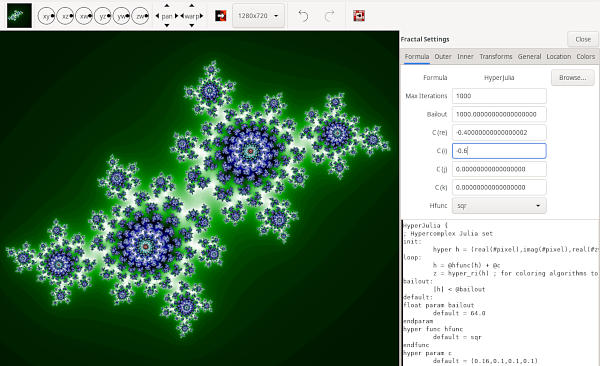

Mathworks - MATLAB
Available for Linux. - https://www.mathworks.com/
"MATLAB is a programming and numeric computing platform used by millions of engineers and scientists to analyze data, develop algorithms, and create models."
GNU Octave
GNU Octave website: Powerful mathematics-oriented scientific programming language with 2D/3D plotting and Matlab script compatibility
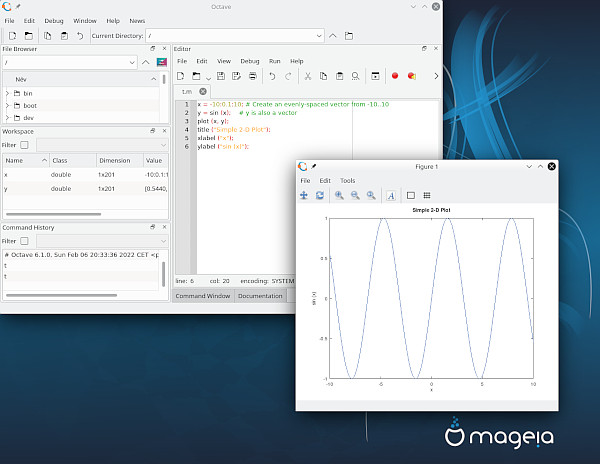
My simple code for Mandelbrot set in GNU Octave:
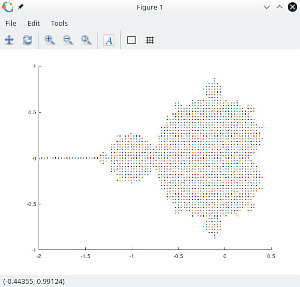
itercount = 1000;
bailout = 10;
step = 0.03 #decrease step for better resolution
x=-2;
y=-1.2;
hold ("on");
for x = -2:step:1
for y=-1.2:step:1.2
n=0;
absz = 0;
a = 0; #complex z = (a,b)
b = 0;
do
newx = a*a - b*b + x; #real of z^2+c
newy = 2*a*b + y; #imag of z^2+c
a = newx; #z(n+1) = (newx, newy)
b = newy;
absz = sqrt(a*a + b*b); #abs(z)
n++;
until ((n==itercount) || (absz>bailout))
if (n==itercount)
plot( x , y ) ;
endif
endfor
endfor
hold ("off");Happily Octave knows arithmetical operations on complex numbers, so you can make easier script.
Mandelbrot_iter.m
#
# Returns the number of succesfull iterations
#
function retval = Mandelbrotxy( z, e, c, maxiter, bailout )
n = 0;
do
z = z.^e + c;
n++;
until ( (abs(z)>bailout) || (n==maxiter) );
retval = n;
endfunctionMandelbrot_set.m
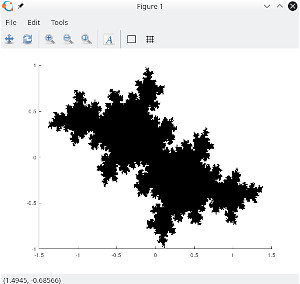
texts = {"Max iteration", "Bailout", "Step","Exponent of z^n+c","cx","cy"};
defaultvalues = {"1000", "10", "0.05","2","0","0"};
inputsizes = [1,10; 1,10; 1,10; 1,10; 1,10; 1,10];
settings = inputdlg (texts, "Settings", inputsizes, defaultvalues);
maxiter = str2num(settings{1});
bailout = str2num(settings{2});
step = str2num(settings{3});
exponent = str2num(settings{4});
cx = str2num(settings{5});
cy = str2num(settings{6});
if (maxiter<=0)
maxiter = 1000;
endif
if (bailout<=0)
bailout = 10;
endif
if (step<=0) || (step>=1)
step = 0.05;
endif
if (exponent<1) || (exponent>=50 )
exponent = 2;
endif
hold('on');
for x= -2:step:2;
for y= -1.2:step:1.2;
if ((cx==0) && (cy==0)) # Mandelbrot
z0 = 0; # z0 = 0;
c = complex(x,y); # (x,y) for Mandelbrot
else # Julia
z0 = complex(x,y); # z0 = (x,y) for Julia
c = complex(cx,cy); # e.g. -0.442444, 0.556128
endif
n = Mandelbrot_iter( z0, exponent, c, maxiter, bailout )
if (n==maxiter)
plot( x, y );
endif
endfor
endfor
hold('off');Plotting to figure is the simplest way for displaying set, more colorfull solution is creating an image and assigning a color from colormap to iteration number. My favourite to create Z with a meshgrid and generate the iteration number matrix at once using filter mask, and the result array can be displayed with imagesc. In this case you can work with result data further more before displaying and also you can save/export for later use and then just have to importdata.
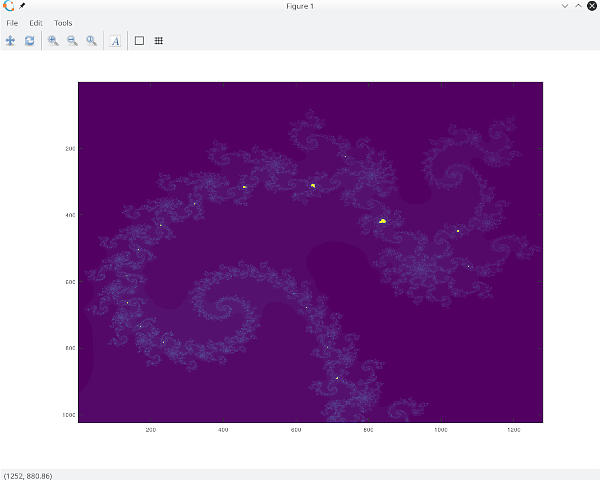
π as Dave Boll discovered:
Calc_PI_with_Mandelbrot.m with (−0.75, ε)
Calculated Pi~: 3.300000
Calculated Pi~: 3.150000
Calculated Pi~: 3.143000
Calculated Pi~: 3.141700
Calculated Pi~: 3.141600
Calculated Pi~: 3.141593
PI = 3,1415926535 ...
#
# Calculate PI with Mandelbrot /discovered by Dave Boll/
#
n = 6; #number of decimals
z0 = 0; # z0 = complex( 0,0 );
exponent = 2;
cx = -0.75; # by Dave Boll
cy = 1/10^n;
c = complex( cx, cy );
bailout = 2;
calcpi = Mandelbrot_iter( z0, exponent, c, 0, bailout );
printf("PI = 3,1415926535 ... /n");
printf("Calculated Pi~: %f /n",calcpi*cy);Another route with (0.25+ε ,0)
Calculated Pi~: 2.529822
Calculated Pi~: 3.000000
Calculated Pi~: 3.067409
Calculated Pi~: 3.120000
Calculated Pi~: 3.133817
Calculated Pi~: 3.140000
Calculated Pi~: 3.141090
Calculated Pi~: 3.141400
Calculated Pi~: 3.141533
Calculated Pi~: 3.141570
Calculated Pi~: 3.141587
PI = 3,1415926535 ...
z0 = 0;
exponent = 2;
for n = 0:1:11;
e = 1/10^n;
cx = 0.25+e;
cy = 0;
c = complex( cx, cy );
bailout = 2;
calcpi = Mandelbrot_iter( z0, exponent, c, 0, bailout );
printf("Calculated Pi~: %f /n",calcpi*sqrt(e));
endfor
printf("PI = 3,1415926535 ... /n");
Refferences:
https://www.cheenta.com/pi-calculating-from-mandelbrot-set-using-julia/
https://www.doc.ic.ac.uk/~jb/teaching/jmc/pi-in-mandelbrot.pdf
GNU bc
"bc is an arbitrary precision numeric processing language." https://www.gnu.org/software/bc/bc.html

Menu
News
3D War game for Linux
You can play with historical vehicles (planes, tanks, ...) worldwide.
Fractal generation, Mandelbrot set, Julia set
WebGL TEST!
Simple test with a dualcone and more 3d objects:
23-07-2016
River fishing is an interesting way to catch fishes in a flowing water...
Me and my friends spent good days at Lake Warali in Baja.
17-05-2015
I tried different Lake, they say there are big fishes. Every time I had fished here I caught 4+ carps too.
may-2012
23-10-2011
03-10-2010
WARNING!!!
You can buy USB FLASH DRIVES and MP3/MP4/MP5 PLAYERS with FAKE memory sizes on the Internet!
Visitcount (since 2021-05-30): 2369


